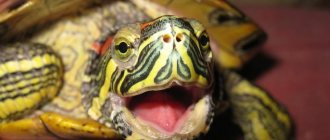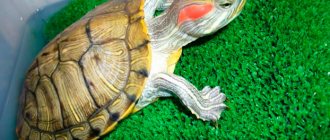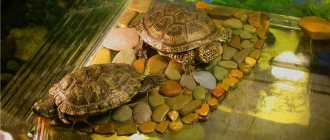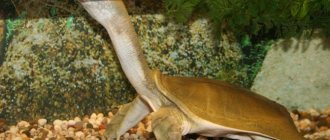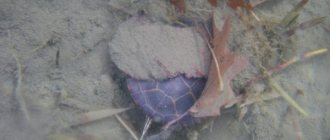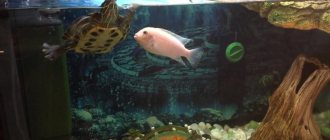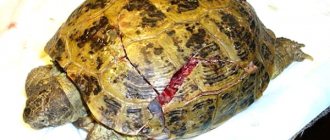Amphibians are in high demand. They are often bred at home for breeding, given to children, or simply bred as a hobby so that there is someone to take care of. Despite the fact that turtles are unpretentious animals and do not require special care, it is still necessary to closely monitor their health. Turtles are especially susceptible to eye diseases. Often, pathogenic bacteria penetrate into them, which can cause severe infections, inflammation and other unpleasant symptoms.
Treatment for a red-eared slider: keep your eyes open
Even the most unpretentious exotic pet gets sick from time to time. The causes and symptoms of the disease may be different. Let's see why the red-eared turtle does not open its eyes and what to do in this or that case. At the same time, we take into account that not in every city you can find a highly qualified veterinarian who will not need to look for a way to solve the problem on the Internet. Therefore, we will consider methods of self-treatment of a patient at an early stage of the disease.
Pneumonia is often asymptomatic, with only decreased appetite and reduced activity.
How to extend the life of a turtle
To prolong the life of a red-eared turtle, it is enough to protect it from diseases and unfavorable conditions. A properly sized terrarium, balanced food, a heating lamp, quarantine for new individuals and timely inspections at least once a month - all this does not require much time, but can serve well.
A pet whose care is given enough attention may well become a long-liver and become familiar to several generations of the same family. To do this, you should get a young individual, for the purchase of which you need to equip a spacious terrarium.
Associated symptoms of the body and behavior
In addition to the main symptoms of diseases of the visual organs in turtles, there are also secondary ones, which include:
- lethargy;
- increased body temperature;
- lack of coordination;
- general weakness.
Important! If there are diseases of the visual organs, the sick pet should be kept in a container without water until complete recovery.
Since the reptile loses its vision and cannot always see food, the amount of food it eats is reduced, and over time it may die.
Uveitis and panophthalmitis
These conditions are characterized by inflammatory processes that can involve various tissues of the eye.
With uveitis, the disease affects the anterior chamber of the uveal tract, and with panophthalmitis, it affects all the membranes of the optic organ. Disturbances develop as a complication of septic pneumonia or as a result of sudden hypothermia. It can also be caused by pathogenic bacteria that have penetrated from the oral cavity into the subcorneal space through the lacrimal canal. With uveitis, the eye remains intact, but pus accumulates under the eyelids. As a rule, inflammation develops bilaterally. In addition, the condition may be accompanied by loss of appetite, exhaustion, rhinitis and lethargy.
Photo: vet.ru
Panophthalmitis manifests itself as a sharp swelling of the eyelids and thickening of the tissues of the visual organ. The turtle's eye becomes like a dense granule filled with pus, with cloudiness in the center.
Treatment of these diseases is carried out surgically, and eye rinsing and antibiotics are also indicated. The selection of drugs and treatment regimen are determined on an individual basis.
Treatment of eye diseases of the red-eared turtle
At the first appearance of symptoms, the animal should be immediately placed in clean water, since it is contaminated water that leads to eye diseases. Since the causative agents are infections, antibiotics and drops are used for treatment.
For medicinal treatment it is possible to use the following pharmaceutical products:
- These can be “Sofradex”, “Tseirolet”, “Albucid”, “Topradex”, which are instilled into the eyes twice a day. If the turtle is unable to open its eyes, then carefully pull back the lower eyelid and apply eye drops. The course of treatment can last from 5 to 10 days, depending on the degree of damage.
- A disease such as panophthalmitis can only be treated with antibiotics and only under the supervision of a veterinarian. Self-treatment is not advisable, as it can lead to the death of the animal.
- If the disease is advanced, there is a high probability that the eyeball will be removed.
- In the process of treating turtle eye disease, it is advisable to enhance the effect by using multivitamins, such as “Intravit”, “Multivit”, “Eleovit”. Since vitamin D2 is poisonous for turtles, you should always pay attention to the content of the corresponding vitamins in the preparations. At the same time, vitamins can be administered by injection, if, of course, the doctor does not mind.
- To alleviate the suffering of the red-eared turtle, it is possible to use chamomile decoction and a solution of boric acid. They moisten swabs and remove plaque from the turtle's eyes.
- At the very beginning of the appearance of signs of the disease, tetracycline ointment can help.
Main diseases of red-eared turtles
A turtle kept in captivity can be susceptible to various diseases. You should know that diseases of red-eared turtles can be infectious and non-infectious, caused by improper feeding or developmental abnormalities. To prevent absolutely all diseases, you need strict control of the diet, clean water in which the pet spends most of its time, and the absence of sharp objects that can injure you. In addition, you can have the turtle examined by a specialist - this will never be superfluous. Next, we will look at the most common diseases of red-eared turtles, their symptoms and possible treatments.
Redness and swelling of the eyes
Red and swollen eyes are the most common condition for red-eared turtles. Typically, the disease is caused by poor diet or contaminated water. To prevent the appearance of redness and swelling, it is necessary to give foods containing carotene. It is also extremely necessary to change the water promptly.
Treatment can be carried out independently, at home. To recover, it is necessary to isolate the pet and not allow it to dive into the water on its own. For just a few hours a day, you can place your turtle in warm water. The eyes must be treated with a three percent solution of boric acid; ointments containing antibiotics can be used as a supplement. An integrated approach to treatment gives the best results. After the redness and swelling disappear, be sure to increase the amount of food containing vitamin A.
Bone diseases, softening of the shell
As a rule, rickets, softening of the bone, detachment of shell particles and its softness are caused by the same reasons. All bone and shell diseases can be caused by two factors:
- insufficient exposure to ultraviolet rays;
- poor absorption of calcium and auxiliary microelements by the turtle’s body.
Symptoms of rickets are a violation of the shape of the bones, the appearance of thickenings. The softness of bones is usually quite difficult to determine immediately. The problem can be identified based on changes in the behavior of the red-eared slider - lethargy, inability to actively move. Changes in the shell are noticeable immediately - irregular detachment of horny particles begins, the shell itself becomes very soft and can even change shape.
Treatment for bone disease consists of taking vitamins containing calcium and vitamin D. It is worth remembering that not all forms of vitamins are absorbed well enough. For proper treatment, you can contact your veterinarian - he will recommend a complex suitable for your pet and may prescribe additional treatment. Introduce small fish that have bones into your diet. Also, to treat and prevent diseases of the bones and shell, it is necessary to periodically irradiate the pet with a lamp that produces ultraviolet rays.
Pneumonia
Inflammation of the lungs (pneumonia) occurs due to hypothermia of the turtle. Pneumonia is a fairly serious disease that, if not detected in time or treated incorrectly, can even be fatal. Symptoms appear already on the second day of the disease and can be immediately noticed. The red-eared turtle will be very lethargic and will spend all its time either on land or on the surface of the water. Even if it wants to dive, the pet will not be able to do this.
Treatment of pneumonia can be medicinal and folk. It is better to resort to a set of measures aimed at recovery. To eliminate the disease, it is necessary to do intramuscular injections. It should be remembered that only a veterinarian can prescribe the optimal dose of the drug - independent calculation can lead to the death of the pet. The folk method is to prepare a warm (not hot) solution of common chamomile. First, you need to hold the turtle over the steam coming from the infusion, then place the pet in the solution itself for half an hour. It is worth remembering that with any treatment of pneumonia it is necessary to maintain the optimal water temperature at all times. When pneumonia occurs, it is 29-30 degrees Celsius.
We looked at the most common diseases that can occur in a red-eared slider. Diseases caused by parasites and infection may also develop. Damage to the skin can also lead to illness. Disorders of the gastrointestinal tract are quite rare. When purchasing a pet, you need to know what the red-eared turtle eats, diseases and treatment, and optimal living conditions. Only if all care conditions are met will you be guaranteed long-term and joyful communication with your pet.
Pneumonia
The answer to the question - why the turtle does not open its eyes may lie in the presence of a cold in the turtle, namely the presence of pneumonia in the reptile. With this disease, in addition to eye problems, other unpleasant symptoms may also be present - frequent coughing, the turtle practically does not eat, it can swim on one side, and also cannot dive.
Pneumonia in amphibians is quite common. The most important thing is not to let this disease progress; in the initial stages it can be cured at home. In these cases, inhalations and warm baths with medicinal herbs will help.
It is important to follow the following useful recommendations when carrying out these treatment procedures:
- Pour dry chamomile into a deep saucepan, add hot water and boil for a while;
- The resulting decoction can be used for inhalation, which must be carried out in the same way as for humans. The turtle can be held suspended on your hand. If the pet is too heavy, then it can be placed on a sieve. Never use a colander made of a metal base, because the animal may receive severe burns;
- After inhalation, the infusion of chamomile can be diluted with water. The prepared solution can be used as a medicinal bath. But it is advisable to cool it to 40-45 0 C;
- It is recommended to bathe your pet for 20-25 minutes, but at the same time monitor the temperature of the liquid. It should not fall below 30 0 C;
- Next, close the turtle in a dry container and warm it there at a temperature not lower than 35 0 C.
It is recommended to continue these procedures until the amphibian animal gets better and makes a full recovery. On average, treatment takes about a week. However, in advanced cases, treatment therapy can last a long period.
Detachment of horny plates
In reptiles that have a shell, some diseases affect even this strong part of the body. In ordinary life, turtles do not break off parts of the carapace, although when an individual is actively growing, this is also possible.
But with age, the redfish begins to grow more and more slowly. If its plates peel off, the owner should worry - this is one of the reactions to a violation of the conditions of detention. The main reasons for this phenomenon are as follows:
- dehydration;
- damage by pathogenic fungal organisms;
- infection with cyanobacteria;
- deficiency of some vitamin components.
If the shield leaves its rightful place evenly, repeating the shape of the substrate, then we are not talking about serious diseases. You should be concerned if there are a number of signs:
- The plate delaminates, and cavities and small bubbles appear in it. This is a sure sign of a fungal infection. If the inner side of the fallen shield or the surface of the regrown plate is covered with a brown crust or grayish coating, then the possibility of a pathogenic process can be excluded. The point is that fungi can only live on dead tissue. A similar thing is observed when blue-green algae penetrates tissue.
- The shield thickens (hypertrophies), and detachment occurs from the middle, from the deep layers. In most cases, you can save your pet from such a nuisance by adjusting the diet - it must be balanced. Also, the sick turtle is prescribed suitable vitamin and mineral formulations.
- The stratum corneum peels off in the same areas, and soft, light spots form. Sometimes under the scutes you can see a fibrous membrane - the periosteum, when wiped with a cotton swab, blood appears. This is a dangerous sign, signaling the development of shell ulcer disease, which English zoologists designate USD. It is caused by pathogenic bacteria.
Therapy for detachment of horny plates includes the following procedures and measures:
- first of all, in case of any violations in the condition of the shell, the conditions in which the reptile is kept should be corrected;
- It is recommended to add a small amount of methylthionium chloride to the water for several weeks until it turns blue;
- for carapace ulcers, in addition to adding blue, it is necessary to use the antifungal drug “Clotrimazole” in the form of an ointment;
- if required, medications with antimycotic effects are prescribed.
It is important to consider that when treating such turtle pathologies, reptiles require some changes in living conditions. It is advisable that they spend the night time on land
Turtle cannot dive into water
The reptile has difficulty diving and drifts in an inclined position on the water surface. It is difficult for the turtle to stay under water or it cannot be there at all; mucus discharge appears from the nose and mouth. The cause is most often infectious diseases of the respiratory tract due to hypothermia.
Treatment:
- increase the temperature of water and air;
- increase air humidity. However, the air should not be stuffy;
- inhalation of chamomile vapor. The chamomile decoction is heated in the container so that the reptile located directly above it on the grate can inhale warm (up to +30-35 C) vapors.
How to determine if your pet is hibernating
It is quite difficult to distinguish hibernation from death if you do not know certain signs of a living reptile in suspended animation and a dead turtle.
What signs indicate the death of a pet:
- Open mouth.
- Lack of response to light and pain. Shine a light into the reptile's eyes and try to prick its paw with a toothpick.
- Sunken eyes (does not always indicate death).
- Unnatural color of mucous membrane. In living individuals it has a pinkish tint, in dead ones it is gray with a bluish tint.
- Lack of response to heat. Place the reptile in warm water or near a light heat source.
- Rotten corpse smell. The smell appears a couple of days after death. You will most likely notice obvious external signs of decomposition.
If the signs of death are not obvious, for example, sunken eyes, you should contact a specialist at a veterinary clinic, who will determine what is wrong with your pet.
Prevention
In order to prevent eye problems in your pet, you should adhere to the following recommendations:
- Inspect your turtle's eyes regularly;
- observe the coordination of the animal’s movement;
- change the water in the aquarium regularly;
- feed your reptile healthy food that contains vitamins and nutrients;
- Monitor the temperature of the water in the aquarium - it should not be cold.
To ensure that your pet is always healthy and makes you happy, pay attention to it and take care of its health. Unfortunately, animals often suffer from the same ailments as people and need timely treatment and care.
Treatment
The treatment of ophthalmological diseases in turtles should be carried out by a competent specialist; the earlier therapeutic measures are prescribed, the greater the chance of saving the eyesight and life of the pet. Self-medication without a diagnosis can cause the death of a little friend.
Conjunctivitis and eye burns can be cured on your own by washing the eyes of an aquatic animal with Ringer-Locke solution and instilling anti-inflammatory drops Albucid, Tobradex. It is necessary to instill veterinary drugs into the closed eye of a pet, followed by retracting the lower eyelid so that the drop falls on the conjunctiva.
Blepharoconjunctivitis, uveitis, panophthalmitis, keratitis and complicated conjunctivitis in reptiles are treated with antibacterial drugs: decamethoxin, tsipromed, tsiprovet, tetracycline ointment. For itchy eyes, hormonal drugs are prescribed simultaneously with antibiotics: Sofradex, Hydrocortisone. To increase the body's resistance and achieve a positive effect of the therapy, turtles are prescribed injections of vitamins and immunostimulants.
An important condition in the treatment of eye diseases is limiting the presence of the red-eared turtle in water, correcting the diet and living conditions. A sick reptile must be placed in a warm terrarium with a bathtub installed in it, filled to the level of 2/3 of the height of the pet’s body. The animal should be irradiated daily under an ultraviolet lamp for reptiles and receive warm anti-inflammatory baths in chamomile decoction 2 times a day.
It is necessary to include calcium-containing foods of animal origin in the diet of a small patient: sea fish, shrimp, squid, and shellfish. The animal must receive fresh greens, carrots and cabbage. It is recommended to treat your pet with liver once a week.
Who is better boy or girl
Visual differences between males and females in turtles appear after puberty is complete. Until two years of age, it is impossible to accurately determine whether a boy or a girl is hiding under the shell. For solitary confinement, the difference is not fundamental.
Females of any turtle species will carry out their natural program of laying eggs, even without contact with a male. If more than two years have passed since the last meeting with a representative of the opposite sex, there will be no offspring. The reptile's body requires vitamin support during this period. In rare cases, the process can negatively affect the health of the pet. Male land turtles are usually noisier than females. They are more active and more likely to show aggression.
If you need to choose a second turtle, the introduction will have to be carefully planned. Boys of any breed rarely get along with each other. Girls are more suitable for pair housing. When an opposite-sex couple lives together, the male can oppress the female. Turtles feel comfortable alone.
Causes
Even if the conditions are close to ideal for a turtle, it can still get sick. In this case, there may be inflamed eyelids. They become inflamed due to conjunctivitis, pneumonia or rhinitis. It is recommended that the examination be carried out by a specialist, although not everywhere there are doctors who are able to diagnose turtles and identify the true reason why the reptile’s eyes do not open.
Sometimes it happens that after expensive treatment, a pet does not recover, but becomes even more ill. This is caused by the use of drugs against turtle disease that are used inappropriately. In other words, the drugs are intended for cats and other pets.
So, the main reasons why the red-eared turtle does not open its eyes are:
- Sleep or hibernation. Depending on the conditions, it can be for 2-3 months. If there are no obvious signs of illness in your eyes, then you don’t have to worry and wait for your pet to wake up.
- If there is a white hymen in the eyes, then the cause is improper content or lack of UV radiation.
- If the eyelids are swollen and red, it means your pet has a cold or other infectious disease. This reason is the worst for reptiles.
So, having learned all the causes of closed eyes, you need to know the main diseases and methods of treating them.
If a red-eared turtle does not open its eyes, or its appearance and behavior alarms you, a number of different factors may be responsible for this. The first is vitamin A hypovitaminosis. Its deficiency manifests itself with an unbalanced diet and the lack of a sufficient amount of plant food. Another reason is unsanitary conditions in the aquaterrarium.
- Avoid vitamin A deficiency. This means including fresh greens and other vitamin-rich foods in your diet. Many owners of reptiles mistakenly believe that food purchased at a pet store will fully satisfy their pets’ needs for nutrients and multivitamins. In fact, this is not true.
The diet should be carefully thought out, and natural products should be its main component.
- Take vitamin supplements. You will achieve maximum results from their use by first consulting with your veterinarian. He will tell you which manufacturer to give preference to, what is the optimal dosage and course duration. But keep in mind: if you follow a diet that includes foods rich in vitamins and minerals, the use of supplements is not necessary.
- And, of course, to prevent infections, always keep the aquaterrarium water clean. Many reptile owners resort to special filters. Their installation will purify water from ammonia and nitrites. These substances irritate the sensitive tissues of the eye, which ultimately leads to the development of diseases. To assess the performance of the filter, you can purchase a set of indicators at the pet store that determine the level of ammonia and nitrites in the water. As a result of the inspection, they must show their absence. Otherwise, the filter you purchased is not effective.
Have you read it? How to protect indoor flowers from cats
Frequent pneumonia
If a red-eared turtle coughs, eats poorly, swims sideways, cannot dive and does not open its eyes, it is a 100% cold. The sore is not uncommon, unpleasant, but at the initial stage it is curable even at home. In this case, warm baths and inhalations with chamomile are effective. What does that require:
- Brew a strong decoction of a medicinal plant in a deep saucepan and inhale it as for a person. Your own nasopharynx will be an excellent indicator of temperature. As an option, a hand in which you can hold a suspended turtle is also suitable. The procedure will take at least 10 minutes, so if it’s hard to hold your hand suspended for so long, use a sieve, but not a metal colander. Otherwise, the pet will get burns.
- Upon completion of the inhalation, dilute the chamomile infusion with water to a temperature of 40-45ºC and give your client a bath. It is important that the temperature does not drop below 30ºС. It’s good if a sick pet splashes around in the healing infusion for at least 20-25 minutes.
- Then you need to warm the reptile for four hours in a dry container at a temperature not lower than 35ºC.
Such procedures need to be repeated a couple of times a day until the reptile recovers. Typically, the process takes about a week. But there are also more complex diseases that require a special approach.
Complex rhinitis
Many novice breeders often wonder what to do if a red-eared turtle sneezes, scratches its eyes, blows its nose, and at the same time has difficulty swimming. In this case, it won’t hurt to take a close look at the nostrils and inner corners of your pet’s eyes - they are inflamed with rhinitis. Further treatment depends on the causes of rhinitis:
- Polluted water. In this case, you cannot avoid a procedure that is unpleasant for the reptile and time-consuming for the owner - to rinse the turtle’s nasal passages with an antiseptic liquid using a syringe without a needle. A weak solution of furatsilin or chamomile at a comfortable temperature is suitable as an antiseptic.
- Another cause of a runny nose in a reptile may be improper feeding and, as a result, a lack of vitamin A. In this case, intramuscular injections of the vitamin or increased feeding with food containing it are recommended.
- Rhinitis and swelling of the eyes also occurs with hypothermia.
Features of conjunctivitis
If the turtle's eyes do not open, this may indicate the presence of conjunctivitis.
At the initial stage, inflammation of only one visual organ is observed, but if this disease is started, the inflammatory process can spread to both eyes. In addition, when the disease starts, the mucous membrane of the eye becomes dark red. Often this disease occurs due to dirty water. For this reason, it needs to be cleaned regularly. But you shouldn’t rely on a filter, because this device cannot clean it of all contaminants.
Features of therapeutic therapy:
- first of all, the amphibian animal should be placed in a separate clean and dry container;
- It is imperative to completely disinfect the aquaterrarium;
- the turtle must be washed in warm water;
- after bathing your pet, you need to thoroughly, but very carefully wipe it with a paper towel;
- In the morning, at lunchtime and in the evening, it is recommended to instill sodium sulfacyl (also called albucid) into the eyes;
- If the damage is severe, it may be necessary to apply tetracycline ointment to the eyes.
The swelling will subside on the same day, in the evening. And your eyes will open the next morning. But with severe inflammation, treatment may take relatively longer.
Note! Before placing the reptile in the aquarium, it is recommended to add a couple of drops of methylene blue to the water, but this product must first be diluted with a small amount of water.
What factors can cause eye problems?
A healthy turtle usually sleeps very little, but it arrives in excellent condition both day and night. It is advisable to observe the animal throughout the day. If the reptile constantly sleeps and arrives in a lethargic state, then this may indicate the beginning of the development of a certain illness. But the eyes can be clear, shiny, and wide open.
If suspicious symptoms are detected, you can immediately adjust the turtle’s living conditions. Thus, health problems in an amphibian animal can be caused by the following factors:
- reduced water temperature;
- insufficient use of an ultraviolet lamp or its complete absence;
- very cold water;
- unbalanced diet;
- poor water filtration, irregular bottom cleaning.
If all these factors are corrected, but the turtle still does not open its eyes for 6 hours, this will mean that it has a pathological process. In this case, it is necessary to identify exactly what disease has affected the turtle.
But in any case, you need to stock up on the following resources:
- Prepare a medium container (small aquarium). It will be needed for quarantine;
- It is advisable to buy pharmaceutical chamomile;
- Methylene blue;
- Cotton swabs or swabs.
Of course, other medications may be required, but this will depend on what ailment has affected the pet. For this reason, it is worth knowing the main eye diseases and what to do if you have them.
DISEASES AND TREATMENT
Conjunctivitis
Signs - one or both eyes close and swell, the mucous membrane may turn purple.
Treatment begins with transplanting the turtle from the aquarium into a separate basin without water. Conjunctivitis is often caused by bacteria and germs getting into the eyes.
Keeping turtles in water promotes their reproduction, so a sick turtle is kept without water .
A sick pet will benefit from warm (warmer than regular aquarium water) baths with freshly brewed chamomile.
The aquarium must be washed and cleaned to get rid of germs, and new water must be added. For final disinfection, it is advisable to drop a few drops of Mythelen blue into the water. You can return the turtle to the aquarium only after complete recovery.
Pneumonia
Closed eyes often accompany a turtle's cold.
Signs - lethargy of the pet, poor appetite, the turtle floats on the surface of the water and does not sink, but at the same time does not make any movements and seems to float, often cannot dive. May “cough” – make strange sounds with the mouth while sitting on land.
Treatment can be divided into medical and traditional methods.
Adsense clicker for making money on Google AdSense from 500 to 1000 dollars per month
In the first case, an examination by a veterinarian is required. The turtle will need to be weighed, and based on the weight (excluding the shell), intramuscular injections of the prescribed medication will be given. The difficulty of treatment lies in calculating the correct dose, since the slightest overdose leads to the death of the animal.
Veterinarian advice: help with eye disease
The traditional method of treatment does not pose any dangers, and in non-advanced stages of the disease it is very effective.
The turtle must be removed from the aquarium into a dry container. The room in which it is located must be warm, with dry air, without drafts.
The main medicine in this case is chamomile . A strong decoction is brewed and two types of procedures are performed on the turtle - “inhalation” and bathing.
Inhalation is aimed at warming the lungs. You need to boil water in a saucepan, brew chamomile in it, and then carry out actions similar to regular cold inhalations. It is best to sit on the bed and place a stool next to it, with a pan of boiling water on it.
To concentrate the heat and prevent the heated air from dissipating throughout the room, you need to cover yourself with a blanket. You can hold the turtle in your hands, but it is even more effective to hold it directly above the pan, without burning it, at a distance of ten centimeters. To avoid the risk of dropping your pet into boiling water, you can place it in a sieve and cover it with something on top, even your palm, and prevent it from getting out.
During this procedure, the turtle breathes a hot chamomile infusion, which is very useful for inflamed lungs.
Sore eyes with pneumonia must be treated in the same way as with conjunctivitis - by instilling albucid into the eyes and applying tetracycline ointment. Chamomile will also treat sore eyes - as an antibacterial agent.
Rhinitis
Turtles also have a runny nose. Most often, due to inflammation of the nose, the eyes become swollen and fester.
Signs include nasal discharge, “sneezing” and squeaking when the turtle breathes.
Treatment is mainly carried out with antibiotics, however, a dry regime (in a basin without water) and chamomile baths can also help here. The main thing is that the turtle is not cold.
With any disease, the main thing is to determine the cause as quickly as possible and begin treatment. It is possible to cure a turtle at home, the main thing is to do it and devote all possible free time to your pet.
And contrary to popular belief, chamomile is an excellent remedy and medicine. If the treatment does not help within two to three days and no improvement is observed, then you should consult a doctor.
Reptiles' eyes are very vulnerable. Pathogenic bacteria often penetrate into them, which leads to the development of various diseases. Owners of red-eared turtles usually face eye problems.
What to do?
A logical question arises: if the red-eared turtle does not open its eyes, what to do? Undoubtedly, the best decision is to visit a veterinarian. Self-medication in this case is contraindicated. However, you can provide an invaluable service to a specialist by describing in detail the condition and behavior of the turtle recently, without missing anything, this will help make the most accurate diagnosis. In addition, it is necessary to create suitable living conditions for the animal:
- Maintain temperature conditions (about 30 degrees on land and about 28 degrees in water).
- Inclusion of sea food in the diet (seafood and special dry food).
- Installation of UV lamp.
- Systematic antimicrobial baths with chamomile decoction at a water temperature of at least 35 degrees and no more than 40 degrees.
How often should red-eared pets be fed?
Young turtles that are less than a year old need to be fed artificial food daily.
. Animals older than one year are fed every other day or two.
Newborn pets should receive fifty percent protein in their food. Most foods intended for turtles meet these requirements.
Adult animals should be given twenty-five percent artificial food, and the remaining percentage in the diet should be occupied by various plants.
In the first days of a red-eared turtle’s life in new conditions, food should be given to it, placing it at the very edge of the water.
Once your pet gets used to it, you can feed it from a bowl on the island.
Please note that the composition and size of artificial feeds differ. Therefore, when purchasing them, you should be guided by what the manufacturers write on the packaging.
